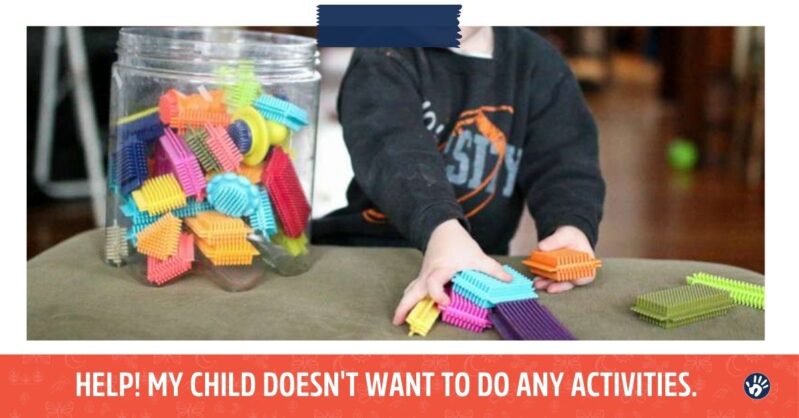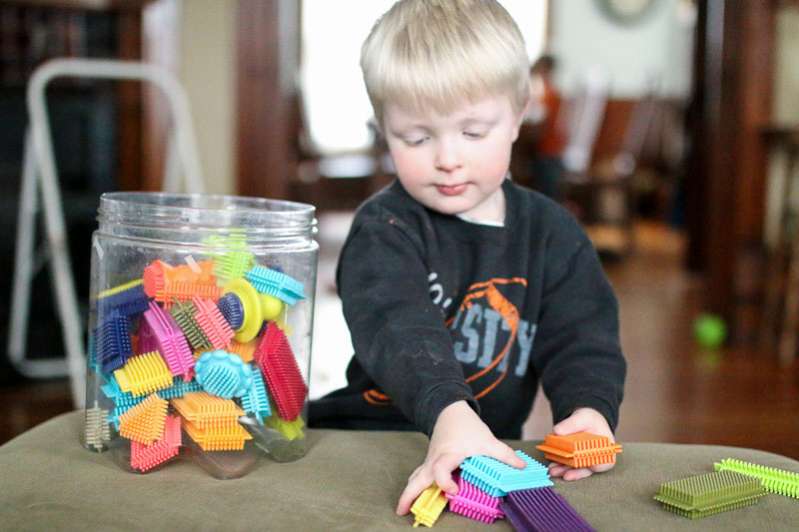Click here to read HELP! My Child Doesn’t Want to Do Any Activities! 4 Steps to Follow on Hands On As We Grow®
My child doesn’t want to do any activities!
My child can’t sit still to do crafts.
My child just destroys the activities we do.
My child just doesn’t seem to want to do any of the activities I set up for him.
Ever said one of those? If that’s the case…
How in the world do you do activities with your child?

First of all, there is nothing is wrong with your child. This is completely normal.
There is somewhat of a learning curve with kids and activities. It doesn’t come naturally to many kids, nor does it come naturally to many parents. At least it didn’t for me at the beginning.
I’ve gone through my phases of forcing my kids to do activities, because I thought that’s what they should be able, and want, to do. And let me tell you, it is not fun for anyone involved. And I always regret it later.
Activities should never cause a fight.
Since then, I’ve found the secret to doing activities with my kids. Let’s go through the 4 steps to follow when your child doesn’t want to do any activities that you encourage.
What’s your reason?
Let’s rewind a bit and talk about your reasons for doing the activities with your child. There’s absolutely no reason that you have to. It’s that you want to. And usually it comes down to wanting to spend time and create memories with your child.
What is your reason? You can find my three reasons here.
If you want to spend time and create memories, then what you’re doing with them shouldn’t really matter all that much, correct?
If he wants to run around and jump when you set up a pipe cleaner threading activity, is that such a terrible thing?
If he destroys the lines of tape you set up to do a jumping game, is that all that bad?
Think about the big picture first and remember your reason for wanting to do the activity in the first place.

What about your child?
Next, I want you to think about your child.
I’ve put this in an email several times, and it’s also in the free activity planner that I send out, but I’ve never made it public.
I realized that this is probably the most important thing you can do with your child, no matter what. But if you want to be successful with activities, you really need to do it even more when your child doesn’t really want to do activities!
You need to study your child.
Step back and watch them as they play. Ask yourself some of these questions about their free play, and even jot down notes in the weekly activities planner. These are just a few examples to get you thinking.
What are they playing with?
What do they talk about?
Do they sit and play, or run around?
Do they tell stories?
Are they focusing in on one thing, or jumping from one toy to another?
What do they gravitate towards?
Do they make up stuff or tend to reenact what’s been going on around them?
Are they builders or destructors?
Make this a Sunday night homework and reflect back on the week, each week.

Then, choose activities based on your child.
Sometimes, an activity might not seem really like an ‘activity’, but just play.
Don’t think you need to be extravagant with activities, especially when you’re first starting out. Simple is often best! Less is more (or however you’d like to say it).
I say this for both you and your child. It makes it not as frustrating for you if your child doesn’t ‘go’ for the activity. But also for your child because its not as frustrating for them if they don’t understand what they’re supposed to do.
Eventually, your child will be asking to do another activity and that’s when you can start making things more involved. But that likely won’t be the case at the beginning.
Do not expect your child to be a certain way and wonder why they don’t want to do an activity; use the information from when your studied your child (above) to form activities around what they’re already interested in. And not just what objects they’re interested in, but how they play with the objects plays a huge part too!
Incorporate the way they play into the activities and you’ll be golden.
Reevaluate your expectations of an activity.
Crafts are often the first thing you might think of when doing an activity. Crafts are also often not well-received by a child at first. Especially to our expectations.
Let’s just be blunt about this, your 15 month old isn’t going to create a perfect wind chime. It just isn’t going to happen.
Instead of focusing on a craft with an end result, focus on the process and exploration of the activity instead of the end result. Let them explore the materials and run around while doing it. The process is where kids learn and have a good time (and memories are made).
Join in the fun while creating and doing activities, your kids will appreciate it and its a special moment together!
Remember to keep it short. Most activities only require 15 minutes of your child’s time. Adjust this to their appropriate attention span, you’ll learn as you do an activity, but this is a good starting point. Don’t be disappointed if the first few times you try an activity, they don’t make it through even the short fifteen minutes (or even five!).

And most importantly, just have fun! Let the kids have fun! Enjoy being a hands-on mom with me!
0 Commentaires